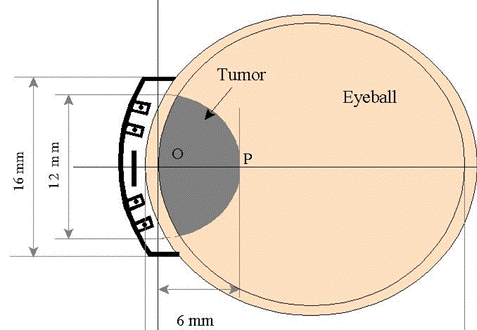A multidisciplinary specialized team comprising of ophthalmogists (specialized in Ocular Oncology), anesthesiologist, oncology surgeons, medical physists, ophthalmic photographers, radiation oncologists, molecular biologists and nurses work closely together with the aim to safely and effectively manage patients with ocular tumours.
A multidisciplinary specialized team comprising of ophthalmogists (specialized in Ocular Oncology), anesthesiologist, oncology surgeons, medical physists, ophthalmic photographers, radiation oncologists, molecular biologists and nurses work closely together with the aim to safely and effectively manage patients with ocular tumours. Additionally, Athens Eye Hospital collaborates with well known-established international oncology units (such as the Liverpool Ocular Oncology Center) for the pathologic evaluation and genetic screening of ocular tumors.
Uveal melanoma is the result of an uncontrolled proliferation of the uveal melanocytes and is the most frequent intraocular tumour in adults.(figure 1A and B). The treatments for the management of Uveal Melanoma (and other intra-ocular tumours) are divided into the conservative and radical treatments. The term conservative treatments refer to these treatments that aim to save (conserve) the eye and if possibly maintain useful vision for the patient, while the term radical treatment refer to removal of the eye with the tumour (in practice, the majority of these patients do not accept the removal of their eye even if their lesion is quite large).
Every patient that presents with an intraocular tumour receives analytical information regarding the nature of his/her condition. Specifically, the therapeutic decision that is thoroughly discussed with the patient ,is based on multiple parameters such as the tumour size, tumour location and the status of the fellow eye.
Additionally, parameters, like the social status and the needs of the patient are taken into consideration. Time to think about the therapeutic options is offered to the patient after the initial consultation, and the patient returns back to our Hospital, few days later to re-discuss the management and to take the final decision with the Multidisciplinary team.
The option for a diagnostic and prognostication biopsy is also given to the patient. These genetic tests offer significant information regarding the metastatic potential of the lesion (in practice many patients do not wish to get this information)

Figure 1A ,1B Choroidal melanoma at the posterior part of the eye(1A,Red arrow) and iris melanoma at the anterior part of the eye (1B,Red arrow)
Ocular Brachytherapy with Ruthenium plaques is the choice of treatment for uveal melanoma (and other intraocular malignancies) in the majority of Ocular Oncology Centers worldwide, with excellent rates of control of the disease.
The term Brachytherapy is used because the radio-active plaque is placed near the lesion( from the Greek word Βραχύς, meaning short distance). Therefore, the emitted β-radiation from the Ruthenium plaque is targeted only to the lesion, resulting in minimal damage in the adjacent structures.(Figure 2)

Figure 2. Ocular Brachytherapy with Ruthenium plaques. The radioactive plaque sutured on the sclera. The plaque remains sutured in the eye for few days until the tumoricidal dose is achieved in order to induce tumor necrosis, without damaging critical structures for vision like the macula or the optic nerve.
Overall the management of patients with intraocular tumors involves tumor detection; diagnosis; patient counseling and care planning; treatment of the
ocular tumor;(the patient usually stays in our hospital for 5-7 days, until the tumor apex receives the tumoricidal dose, approximately 70-100 Gray), detection and treatment of local tumour recurrence and other ocular complications; prognostication; psychological support; screening for metastatic disease.
This is best delivered by our multidisciplinary team.

Figure 3. Example of radioactive plaque location in relation to the lesion. The conventional practice is to position the plaque so that it overlaps the entire tumour margins by 2mm.
In certain cases, the size and the location of the lesion raise the need for combined treatments. Combined treatments mean combination of conservative treatments and refer to the additional local resection of the lesion by means of Endoresection or Exoresection (trans-scleral resection) .
Additionally, Ruthenium Brachytherapy can be followed or preceded by laser treatments such as Transpupillary thermotherapy (TTT) or photodynamic therapy (PDT). All these treatment options are available in Athens Eye Hospital.
Finally , in those cases, that radiation of the lesion results in complications (ex. Toxic Tumour Syndrome) , we complementary proceed to transvitreal local resection of the residual radiated tumour.
Frequently asked questions
How long will I stay in hospital?
The time that you will spend in our hospital depends mostly on the size of the choroidal tumour. In cases with tall tumors, hospitalisation ranges from 5-7 days. In every case, just before your surgery the radiation physist estimates the days needed for the Ruthenium plaque in order to induce necrosis of the tumour.
How much pain will I experience?
In few cases there is some discomfort of the eye, just after the operation. If this is going to be the case with you, then we will give you some casual pain killers (like paracetamol) in order to relief your pain.
If I have a melanoma, arent my chances of survival better if my eye is removed than if it is conserved?
Several studies have shown that as long as the tumor is destroyed by the radiation or by the local resection, the chances of survival are the same whether the eye is removed or whether it is saved.
Can the radiation of the eye cause side effects on other parts of my body or at my accompanying persons?
The radioactive Ruthenium plaques that we use, emmit beta-radiation , that is limited to just few mm in front of the plaque (4-5mm). This practically means that the rest of your body does not receive any radiation nor the accompanying persons. Our hospital has been evaluated by the Greek Atomic Energy Commmitee and conforms to all regulations(standards) for the patients, their relatives and our caring personnel. The patient during his stay in Athens Eye Hospital, rests in a single bedroom.
 German
German Ελληνικά
Ελληνικά